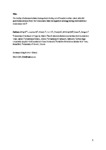The reality of advanced airway management during out of hospital cardiac arrest; why did paramedics deviate from their allocated airway management strategy during the AIRWAYS-2 randomised trial?
| dc.contributor.author | kirby, K | |
| dc.contributor.author | Lazaroo, M | |
| dc.contributor.author | Green, J | |
| dc.contributor.author | Hall, H | |
| dc.contributor.author | Pilbery, R | |
| dc.contributor.author | Whitley, G | |
| dc.contributor.author | Voss, S | |
| dc.contributor.author | Benger, J | |
| dc.date.accessioned | 2023-02-14T12:18:09Z | |
| dc.date.issued | 2023-02-18 | |
| dc.identifier.issn | 2666-5204 | |
| dc.identifier.issn | 2666-5204 | |
| dc.identifier.other | 100365 | |
| dc.identifier.uri | http://hdl.handle.net/10026.1/20350 | |
| dc.description.abstract |
BACKGROUND: AIRWAYS-2 was a large multi-centre cluster randomised controlled trial investigating the effect on functional outcome of a supraglottic airway device (i-gel) versus tracheal intubation (TI) as the initial advanced airway during out-of-hospital cardiac arrest. We aimed to understand why paramedics deviated from their allocated airway management algorithm during AIRWAYS-2. METHODS: This study employed a pragmatic sequential explanatory design utilising retrospective study data collected during the AIRWAYS-2 trial. Airway algorithm deviation data were analysed to categorise and quantify the reasons why paramedics did not follow their allocated strategy of airway management during AIRWAYS-2. Recorded free text entries provided additional context to the paramedic decision-making related to each category identified. RESULTS: In 680 (11.7%) of 5800 patients the study paramedic did not follow their allocated airway management algorithm. There was a higher percentage of deviations in the TI group (399/2707; 14.7%) compared to the i-gel group (281/3088; 9.1%). The predominant reason for a paramedic not following their allocated airway management strategy was airway obstruction, occurring more commonly in the i-gel group (109/281; 38.7%) versus (50/399; 12.5%) in the TI group. CONCLUSION: There was a higher proportion of deviations from the allocated airway management algorithm in the TI group (399; 14.7%) compared to the i-gel group (281; 9.1%). The most frequent reason for deviating from the allocated airway management algorithm in AIRWAYS-2 was obstruction of the patient's airway by fluid. This occurred in both groups of the AIRWAYS-2 trial, but was more frequent in the i-gel group. | |
| dc.format.extent | 100365-100365 | |
| dc.format.medium | Electronic-eCollection | |
| dc.language | en | |
| dc.language.iso | en | |
| dc.publisher | Sciencedirect Elsevier | |
| dc.subject | advanced life support | |
| dc.subject | airway management | |
| dc.subject | emergency medical services | |
| dc.subject | out-of-hospital cardiac arrest | |
| dc.subject | paramedic | |
| dc.subject | resuscitation | |
| dc.title | The reality of advanced airway management during out of hospital cardiac arrest; why did paramedics deviate from their allocated airway management strategy during the AIRWAYS-2 randomised trial? | |
| dc.type | journal-article | |
| dc.type | Article | |
| plymouth.author-url | https://www.ncbi.nlm.nih.gov/pubmed/36860989 | |
| plymouth.volume | 13 | |
| plymouth.publication-status | Published | |
| plymouth.journal | Resuscitation Plus | |
| dc.identifier.doi | 10.1016/j.resplu.2023.100365 | |
| plymouth.organisational-group | /Plymouth | |
| plymouth.organisational-group | /Plymouth/Faculty of Health | |
| plymouth.organisational-group | /Plymouth/Faculty of Health/School of Health Professions | |
| plymouth.organisational-group | /Plymouth/Research Groups | |
| plymouth.organisational-group | /Plymouth/Research Groups/Plymouth Institute of Health and Care Research (PIHR) | |
| plymouth.organisational-group | /Plymouth/Users by role | |
| plymouth.organisational-group | /Plymouth/Users by role/Academics | |
| plymouth.organisational-group | /Plymouth/Users by role/Post-Graduate Research Students | |
| dc.publisher.place | Netherlands | |
| dcterms.dateAccepted | 2023-02-04 | |
| dc.rights.embargodate | 2023-2-21 | |
| dc.identifier.eissn | 2666-5204 | |
| dc.rights.embargoperiod | Not known | |
| rioxxterms.versionofrecord | 10.1016/j.resplu.2023.100365 | |
| rioxxterms.licenseref.uri | http://www.rioxx.net/licenses/all-rights-reserved | |
| rioxxterms.type | Journal Article/Review |


